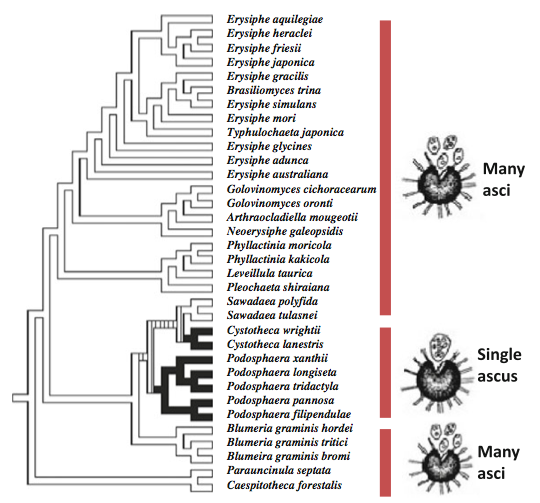Like any organism reproduction is key to the life of the powdery mildews.
Their short generation time and mixture of asexual (self-replication) and sexual life cycles have evolved to produce the veracious organisms which blight many of our agricultural and ornamental plants.
While asexual reproduction (via conidiogenesis) can occur multiple times per year, aiding proliferation throughout a summer, it is often sexual reproduction (occurring just once annually) which maintains viability and allows this fungus to survive the winter.
Fungi sex involves the meeting of two separate, compatible nuclei fusing to form a zygote. The powdery mildew then encase such nuclei in protective layers to aid in longevity (surviving adverse conditions) and dissemination (firing the ascospores into the air on opening).
The coatings are tough and built up, in ‘Russian Doll’-like layers, to protect the sexual ‘ascospores’. These are contained within the sac-like asci enclosed, in varying numbers, within the fruiting body called a chasmothecium. Characteristic of two powdery mildew genera, the Cystotheca and Podosphaera (tribe Cystotheceae), is the presence of just a single asci in each chasmothecia (fig. 1). The remaining genera have plural asci (fig. 1).

Figure 1: The ancestral form of a chasmothecium containing multiple asci (left) and the evolved form, characteristic of the genera Cystotheca and Podosphaera (tribe Cystotheceae), containing a single asci. (From Glawe 2006)
This characteristic has been shown to have evolved on either one or two occasions (fig. 2) from the ancestral plural-ascied chasmothecia (Mori et al. 2000).

Figure 2: Molecular phylogenetic tree of the powdery mildews inferred from the combined data set of the 18S, 28S and 5.8S rDNA sequences. White and black branches indicate many asci and single ascus species, respectively. (From Takamatsu 2013)
References:
Glawe, Dean A. (2006) Synopsis of genera of Erysiphales (powdery mildew fungi) occurring in the Pacific Northwest. Pacific Northwest Fungi 1.12: 1-27.
Mori Y, Sato Y, Takamatsu S. (2000) Evolutionary analysis of the powdery mildew fungi using nucleotide sequences of the nuclear ribosomal DNA. Mycologia 92: 74–93.
Takamatsu, S. (2013) Molecular phylogeny reveals phenotypic evolution of powdery mildews (Erysiphales, Ascomycota). Journal of General Plant Pathology 1-9.

Pingback: Where it all began… | Culham Research Group
Pingback: Powdery mildew morphological glossary | Culham Research Group